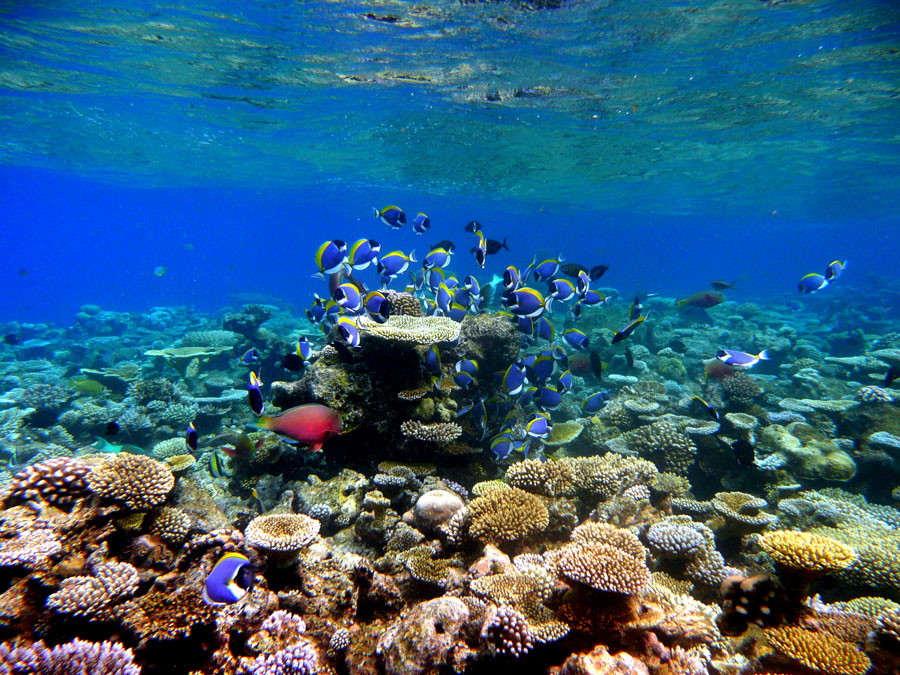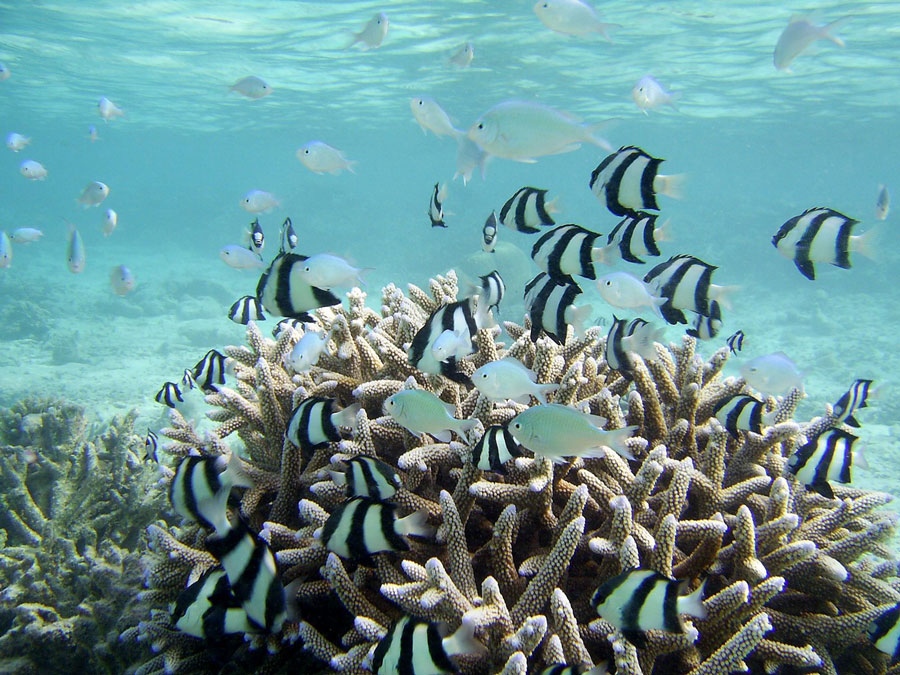The Protective, Intricate Atolls of the Maldives
The Maldives coral atolls are still so unexplored, so untouched, and so pristine, that scientists are just now getting around to documenting the wonders here. Fish never seen before by scientists are having names created for them as we speak. Divers love to explore the lagoons here, hoping to discover a rare type of reef or fish that hasn’t yet been found.
The Maldives are completely made up of atolls – atolls that are in pristine, beautiful condition. The remoteness of many of these atolls have left many of these reefs protected but unexplored throughout time and are still today awaiting exploration.

Tricky Navigation Makes for Pristine Waters and Reef Conditions
The Maldivian reefs are lucky in that these very intricate coral atoll systems here are very hard to navigate by sailors and fishermen, so the marine biodiversity is relatively rich and untouched, with many species of fish that have not been persecuted by poachers.
The intricacy of the atolls here also make it difficult to research the marine diversity here. However, this very intricacy has also protected these reefs—leaving many of them still unexplored by man.
These reefs hold secrets scientists are soon to put under their microscopes. So far, only three of the many reefs here have been studied. These reefs are the Male Atoll, Adu Atoll, and Ari Atoll. But there are 23 other coral atolls still to be explored.
Many of the reefs are formed into rings called faros that float in the lagoons.
As Yet Undocumented Species of Fish and Other Life Here
The 26 coral atolls that make up the Maldives are so rich with biodiversity that the fish here have not yet been documented. So far, 1,000 fish have been discovered here, and three hundred of these had never been seen in these waters until now.
Also, there are seven species of marine animals here that are completely new to science, and, therefore, had to have names created for them.
Over four hundred fish have been identified, and it takes some twenty-four pages to list all of them.

Amazing Biodiversity

In the Maldives, you will also see some of the most colorful reefs in the entire world, protected from shipwrecks, damaging anchors, and overfishing of species that protect the reefs from algae over-population and damage. There are over 187 species of coral.
Among the 1,100 species of fish here, you can see 21 species of whales and dolphins, 145 crab, 48 shrimp, five species of sea turtles, and an amazing array of fish including squirrelfish, soldierfish, glassfish, spotted eagle rays, lobsters, batfish, humphead wrasse, lionfish, pufferfish, fusiliers, butterflyfish, triggerfish, Napoleon wrasses, barracudas, scorpionfish, jalckfish, groupers, eels, oriental sweetips, unicornfish, and angelfish.
Important Scientific Discoveries
Many of the ecosystems here are proving quite valuable to science. In fact, certain sponges were recently discovered that have anti-cancer and anti-tumor properties.
Protect the Maldives
With the rich marine diversity here and the promise of scientific advancement—much of it still undiscovered, it is important we protect these reefs, especially, from the kinds of damage reefs experience from man and nature.
Several species of fish here are forbidden for fishery, as well as all turtles , black corals, giant corals, dolphins, whale sharks, and whales, Napoleon Wrasse, and some lobsters.
But it is important we protect these reefs in other ways as well.
Fishing
Fishing for tuna is a major industry in the Maldives. Of special concern is the fishing of unknown and exotic species of fish here to sell that may be rare, endangered species. These fishermen have also completely depleted the waters of giant clams and so, it is evident that these masses of fishermen have the capability to completely annihilate whole species of marine life.
Coral Bleaching
Coral bleaching is not just caused by human damage to our earth, it is also caused by temperatures rising from storms. El Nino caused massive rising of temperatures here, well past 90 degrees Fahrenheit that caused massive coral bleaching.
Mining and Runoff’
Coral mining is also a severe problem in the Maldives. The miners are striving to collect large masses of corals to build walls for new structures. In one day, these miners destroy huge masses of coral and the runoff and chemicals put into the water because of mining will threaten coral with destruction for many years to come.
The New Atlantis?
Many conservationists are highly critical of the Maldives – saying their reefs are abused and exploited. In an article titled “Maldives: The Next Atlantis,” Captain Lockhart MacLean notes that
The Maldivian islands, once considered a global leader in sustainable fishing and climate change talks, spurred on by the Republic’s vulnerability to sea level rise, now seem to be spiraling into the lucrative abyss of long lining, marine mammal trafficking, unsustainable aquaculture, and destruction of habitat.
Many concerned activists are now calling this island “the new Atlantis”—because like Atlantis, they predict the Maldives to become another once-thriving and beautiful city that will be destroyed by shortsightedness and greed.
http://www.seashepherd.org/commentary-and-editorials/2011/12/10/maldives-the-next-atlantis-497
